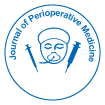
Journal of Perioperative Medicine
Open Access
ISSN: 2684-1290

ISSN: 2684-1290
Short Communication - (2025)Volume 8, Issue 1
Preoperative anxiety is a frequently overlooked but clinically significant factor that can influence the entire perioperative experience, especially in ambulatory (same-day) surgical procedures. The prevalence of moderate-to-severe anxiety in preoperative patients can exceed 60% and such anxiety has been associated with increased anesthetic requirements, delayed recovery, higher pain scores and poor patient satisfaction. As same-day surgeries continue to rise in high-income countries due to cost-efficiency and convenience, optimizing perioperative outcomes has become increasingly important. This short communication highlights the impact of non-pharmacological preoperative anxiety-reducing interventions on postoperative recovery metrics in ambulatory surgery patients. The focus is on simple, scalable methods including guided breathing, music therapy, preoperative counseling and virtual reality exposure.
A prospective observational cohort study was conducted at St. Thomas University Hospital, London, over a six-month period (January–June 2025), involving 120 adult patients scheduled for elective ambulatory surgeries under general anesthesia. Patients were divided into two groups: Intervention Group (n=60) and Control Group (n=60). The intervention group received a structured anxiety-reduction protocol 30–60 minutes before surgery, which included a 10-minute breathing exercise session followed by guided imagery or soothing music via headphones. Additionally, a brief session with a perioperative nurse provided reassurance and detailed procedural explanations. The control group received standard preoperative care, including standard verbal instructions and routine anesthetic consent. Preoperative anxiety was assessed using the Amsterdam Preoperative Anxiety and Information Scale (APAIS) and postoperative recovery was measured using multiple parameters:
The baseline demographics (age, gender, ASA score, type of surgery) were matched between both groups. Results demonstrated a significant reduction in anxiety scores in the intervention group (mean APAIS score 12.4 vs. 18.7, p < 0.01). Additionally, the intervention group showed:
These findings support previous international studies suggesting that anxiety-reduction strategies may enhance physiological and psychological resilience in perioperative patients. Interestingly, patients also reported a greater sense of control and reduced fear about anesthesia and surgical outcomes. The implications of this study are particularly relevant to high-income countries where ambulatory surgery centers are growing rapidly. While pharmacologic sedation is sometimes used for anxious patients, it carries its own risks and costs. By contrast, non-pharmacologic interventions are cost-effective, have no side effects and are wellaccepted by patients. Further, implementing such interventions requires minimal training and resources. A standard anxietyreduction protocol could be easily incorporated into the workflow of preoperative assessment units without disrupting surgical schedules. It may also improve institutional quality indicators like patient satisfaction and reduced unplanned admissions or delayed discharges.
Preoperative anxiety is a modifiable risk factor that can significantly affect postoperative recovery metrics in ambulatory surgery patients. This short communication provides preliminary evidence that structured, non-pharmacological anxiety-reduction interventions particularly those incorporating breathing techniques, music therapy and personalized nurse counselling can positively impact patient outcomes. The observed benefits include reduced pain and nausea, quicker recovery and improved patient satisfaction, all of which are essential metrics for the success of ambulatory surgery programs. Given the low cost, ease of implementation and patient acceptance of such interventions, there is a strong rationale for integrating them into standard perioperative care in highincome healthcare settings. Future research could focus on largescale randomized controlled trials to validate these findings across diverse populations and surgical specialties and to explore digital delivery methods such as mobile Health (mHealth) tools for anxiety management.
[Crossref] [Google Scholar] [Pubmed]
[Crossref] [Google Scholar] [Pubmed]
[Crossref] [Google Scholar] [Pubmed]
[Crossref] [Google Scholar] [Pubmed]
[Crossref] [Google Scholar] [Pubmed]
[Crossref] [Google Scholar] [Pubmed]
[Crossref] [Google Scholar] [Pubmed]
[Crossref] [Google Scholar] [Pubmed]
[Crossref] [Google Scholar] [Pubmed]
Citation: Harding EL (2025). Impact of Preoperative Anxiety Reduction Interventions on Postoperative Recovery Metrics in Ambulatory Surgery Patients. J Perioper Med. 8:270.
Received: 05-Feb-2025, Manuscript No. JPME-25-38291; Editor assigned: 07-Feb-2025, Pre QC No. JPME-25-38291 (PQ); Reviewed: 22-Feb-2025, QC No. JPME-25-38291; Revised: 02-Mar-2025, Manuscript No. JPME-25-38291 (R); Published: 09-Feb-2025 , DOI: 10.35248/2684-1290.25.8.270
Copyright: © 2025 Harding EL. This is an open-access article distributed under the terms of the Creative Commons Attribution License, which permits unrestricted use, distribution, and reproduction in any medium, provided the original author and source are credited.